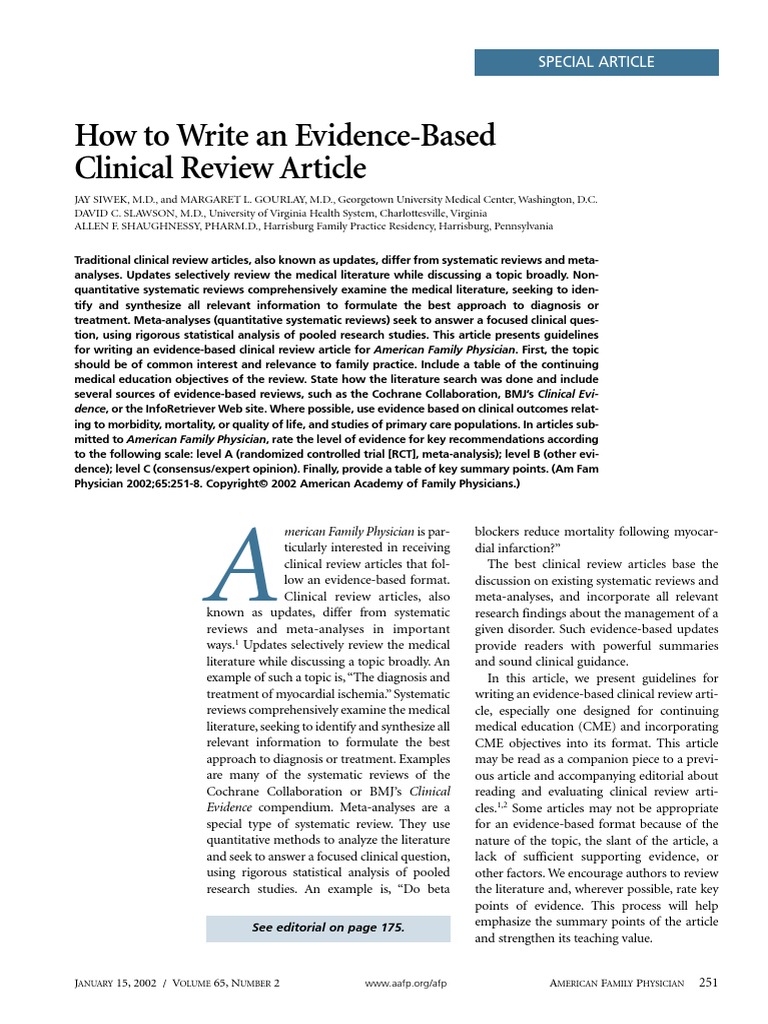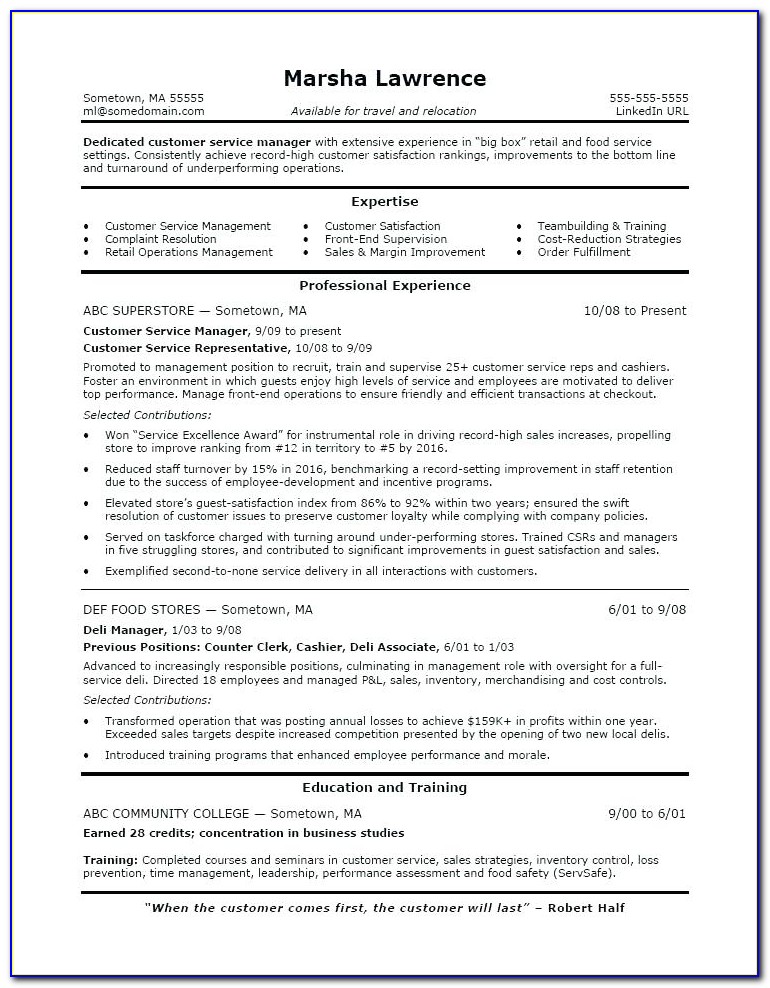
Methods: The steps of a successful systematic review include the following: identification of an unanswered answerable question; explicit definitions of the investigation's participant(s), intervention(s), comparison(s), and outcome(s); utilization of PRISMA (Preferred Reporting Items for Systematic Reviews and Meta-analyses) guidelines and PROSPERO registration; thorough systematic data extraction; and appropriate grading of the evidence and strength of the blogger.com by: · Essential Steps in Writing an Evidence-Based Clinical Review Article Choose a common, important topic in family practice. Provide a table with a list of continuing medical education (CME) Cited by: Siwek J, Gourlay ML, Slawson DC, Shaughnessy AF. How to write an evidence-based clinical review article. Am Fam Phys ;– Google Scholar
How to Write a Review Article | SpringerLink
JAY SIWEK, M. GOURLAY, M. DAVID C. SLAWSON, M. ALLEN F. Traditional clinical review articles, also known as updates, differ from systematic reviews and meta-analyses. Updates selectively review the medical literature while discussing a topic broadly. Nonquantitative systematic reviews comprehensively examine the medical literature, seeking to identify and synthesize all relevant information to formulate the best approach to diagnosis or treatment.
Meta-analyses quantitative systematic reviews seek to answer a focused clinical question, using rigorous statistical analysis of pooled research studies. This article presents guidelines for writing an evidence-based clinical review article for American Family Physician.
First, the topic should be of common interest and relevance to family practice. Include a table of the continuing medical education objectives of the review.
State how the literature search was done and include several sources of evidence-based reviews, such as the Cochrane Collaboration, BMJ's Clinical Evidenceor the InfoRetriever Web site. Where possible, use evidence based on clinical outcomes relating to morbidity, mortality, or quality of life, and studies of primary care populations.
Finally, provide a table of key summary points. American Family Physician is particularly interested in receiving clinical review articles that follow an evidence-based format. Clinical review articles, how to write a review article in medicine, also known as updates, differ from systematic reviews and meta-analyses in important ways.
Examples are many of the systematic reviews of the Cochrane Collaboration or BMJ's Clinical Evidence compendium. Meta-analyses are a special type of systematic review. They use quantitative methods to analyze the literature and seek to answer how to write a review article in medicine focused clinical question, using rigorous statistical analysis of pooled research studies.
The best clinical review articles base the discussion on existing systematic reviews and meta-analyses, and incorporate all relevant research findings about the management of a given disorder.
Such evidence-based updates provide readers with powerful summaries and sound clinical guidance. In this article, we present guidelines for writing an evidence-based clinical review article, especially one designed for continuing medical education CME and incorporating CME objectives into its format. This article may be read as a companion piece to a previous article and accompanying editorial about reading and evaluating clinical review articles.
We encourage authors to review the literature and, wherever possible, rate key points of evidence. This process will help emphasize the summary points of the article and strengthen its teaching value. Choose a common clinical problem and avoid topics that are rarities or unusual manifestations of disease or that have curiosity value only. Whenever possible, choose common problems for which there is new information how to write a review article in medicine diagnosis or treatment.
Emphasize new information that, if valid, should prompt a change in clinical practice, such as the recent evidence that spironolactone therapy improves survival in patients who have severe congestive heart failure. For example, patching most traumatic corneal abrasions may actually cause more symptoms and delay healing compared with no patching. When searching the literature on your topic, how to write a review article in medicine, please consult several sources of evidence-based reviews Table 1.
Look for pertinent guidelines on the diagnosis, treatment, or prevention of the disorder being discussed. Incorporate all high-quality recommendations that are relevant to the topic. When reviewing the how to write a review article in medicine draft, look for all key recommendations about diagnosis and, especially, treatment. Try to ensure that all recommendations are based on the highest level of evidence available. If you are not sure about the source or strength of the recommendation, return to the literature, seeking out the basis for the recommendation.
The AHRQ Web site includes links to the National Guideline Clearinghouse, Evidence Reports from the AHRQ's 12 Evidence-based Practice Centers EPCand Preventive Services. The AHCPR released 19 Clinical Practice Guidelines between and that were not subsequently updated. American College of Physicians Journal Club ACPJC. ACP Journal Club evaluates evidence in individual articles. Commentary by ACP author offers clinical recommendations. Access to the online version of ACPJC is a benefit for members of the ACP-ASIM, but will be open to all until at least the end of The AHRQ began the Translating Research into Practice TRIP initiative in to implement evidence-based tools and information.
The TRIP Database features hyperlinks to the largest collection of EBM materials on the internet, including NGC, POEM, DARE, Cochrane Library, CATbank, and individual articles. A good starting place for an EBM literature search. Searches BMJ's Clinical Evidence compendium for up-to-date evidence regarding how to write a review article in medicine health care. Lists available topics and describes the supporting body of evidence to date e. Systematic evidence reviews that are updated periodically by the Cochrane Group.
Reviewers discuss whether adequate data are available for the development of EBM guidelines for diagnosis or management. Structured abstracts written by University of York CRD reviewers see NHS CRD. Abstract summaries review articles on diagnostic or treatment interventions and discuss clinical implications. Bi-monthly, peer-reviewed bulletin for medical decision-makers. Based on systematic reviews and synthesis of research on how to write a review article in medicine clinical effectiveness, cost-effectiveness and acceptability of health service interventions.
Bimonthly publication launched in by the BMJ Publishing Group. Article summaries include commentaries by clinical experts, how to write a review article in medicine. Subscription is required. This JFP newsletter features up-to-date POEM, Disease-Oriented Evidence DOEhow to write a review article in medicine, and tests approved for Category 1 CME credit.
Subscription required. Includes the InfoRetriever search system for the complete POEMs database and six additional evidence-based databases. ICSI is an independent, nonprofit collaboration of health care organizations, including the Mayo Clinic, Rochester, Minn. Web site includes the ICSI guidelines for preventive services and disease management. Comprehensive database of evidence-based clinical practice guidelines from government agencies and health care organizations.
Describes and compares guideline statements with respect to objectives, methods, outcomes, evidence rating scheme, and major recommendations. National Health Service NHS Centre for Reviews and Dissemination CRD. Searches CRD Databases includes DARE, NHS Economic Evaluation How to write a review article in medicine, Health Technology Assessment Database for EBM reviews.
More limited than TRIP Database. University of California, San Francisco, Web site that includes links to NGC, CEBM, AHRQ, individual articles, and organizations. This Web site features updated recommendations for clinical preventive services based on systematic evidence reviews by the U. Preventive Services Task Force. When these sources are used to prepare continuing medical education clinical content according to guidelines issued by the AAFP Commission of Continuing Medical Education, the content will qualify for the special designation of evidence-based CME.
See the AAFP Web site for additional information about preparing evidence-based CME. In particular, try to find the answer in an authoritative compendium of evidence-based reviews, or at least try to find a meta-analysis or well-designed randomized controlled trial RCT to support it. If none appears to be available, try to cite an authoritative consensus statement or clinical guideline, such as a National Institutes of Health Consensus Development Conference statement or a clinical guideline published by a major medical organization.
If no strong evidence exists to support the conventional approach to managing a given clinical situation, point this out in the text, especially for key recommendations. Keep in mind that much of traditional medical practice has not yet undergone rigorous scientific study, and high-quality evidence may not exist to support conventional knowledge or practice. With regard to types of evidence, how to write a review article in medicine, Shaughnessy and Slawson 5 — 7 developed the concept of Patient-Oriented Evidence that Matters POEMin distinction to Disease-Oriented Evidence DOE.
POEM deals with outcomes of importance to patients, such as changes in morbidity, mortality, or quality of life. DOE deals with surrogate end points, such as changes in laboratory values or other measures of response. Although the results of DOE sometimes parallel the results of POEM, they do not always correspond Table 2. When DOE is the only guidance available, indicate that key clinical recommendations lack the support of outcomes evidence. Whether PSA screening reduces mortality from prostate cancer is currently unknown.
Adapted with permission from Shaughnessy AF, Slawson DC. Getting the most from review articles: a guide for readers and writers.
Am Fam Physician ;— Evaluate the strength and validity of the literature that supports the discussion see the following section, Levels of Evidence. Look for meta-analyses, high-quality, randomized clinical trials with important outcomes POEMor well-designed, nonrandomized clinical trials, clinical cohort studies, or case-controlled studies with consistent findings.
In some cases, high-quality, historical, uncontrolled studies are appropriate e. Avoid anecdotal reports or repeating the hearsay of conventional wisdom, which may not stand up to the scrutiny of scientific study e.
Look for studies that describe patient populations that are likely to be seen in primary care rather than subspecialty referral populations. Shaughnessy and Slawson's guide for writers of clinical review articles includes a section on information and validity traps to avoid. Readers need to know the strength of the evidence supporting the key clinical recommendations on diagnosis and treatment. Many different rating systems of varying complexity and clinical relevance are described in the medical literature.
Recently, the third U. Preventive Services Task Force USPSTF emphasized the importance of rating not only the study type RCT, cohort study, case-control study, etc. While it is important to appreciate these evolving concepts, we find that a simplified grading system is more useful in AFP. We have adopted the following convention, using an ABC rating scale. Criteria for high-quality studies are discussed in several sources.
High-quality meta-analysis quantitative systematic review using comprehensive search strategies. Level B other evidence : A well-designed, nonrandomized clinical trial.
Writing a Review Article: Choosing a Topic
, time: 11:08How to write a ‘Review of Literature’ | communitymedicine4all

Read the entire article first and then go back and take notes. Jot down notes in your own words. This increases comprehension as well as decreases the likelihood of plagiarism. The review is written in third person; no “I” or “you” · Essential Steps in Writing an Evidence-Based Clinical Review Article Choose a common, important topic in family practice. Provide a table with a list of continuing medical education (CME) Cited by: Methods: The steps of a successful systematic review include the following: identification of an unanswered answerable question; explicit definitions of the investigation's participant(s), intervention(s), comparison(s), and outcome(s); utilization of PRISMA (Preferred Reporting Items for Systematic Reviews and Meta-analyses) guidelines and PROSPERO registration; thorough systematic data extraction; and appropriate grading of the evidence and strength of the blogger.com by:

No comments:
Post a Comment